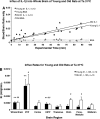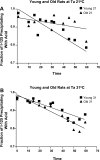A warmer ambient temperature increases the passage of interleukin-1beta into the brains of old rats
- PMID: 18448612
- PMCID: PMC2494802
- DOI: 10.1152/ajpregu.00104.2007
A warmer ambient temperature increases the passage of interleukin-1beta into the brains of old rats
Abstract
We have demonstrated that after intraperitoneal lipopolysaccharide (LPS) injection, old rats mount fevers similar to those of young rats at an ambient temperature (Ta) of 31 degrees C, but not at 21 degrees C. The same is true for intraperitoneal or intravenous IL-1beta administration. The underlying mechanism responsible for blunted fever in old rats may be a deficiency in communication between the periphery and the brain. Possibly, peripheral cytokine actions are altered in old rats, such that the signal that reaches the brain is diminished. Here, we hypothesized that at standard laboratory temperatures, not enough IL-1beta is reaching the brain for fever to occur and that a warmer Ta would increase the influx of IL-1beta into the brain, enabling old rats to generate fever. Young (3-5 mo) and old (23-29 mo) Long-Evans rats were maintained for 3 days at either Ta 21 or 31 degrees C prior to intravenous injection with radiolabeled IL-1beta to measure passage across the blood-brain barrier. Young rats showed similar influx of IL-1beta into the brain at the two Tas, but old rats showed significant influx only at the warmer Ta. These data suggest that the lack of fever at a cool Ta may be due to a reduced influx of IL-1beta into the brain.
Figures




Similar articles
-
Influence of ambient temperature on peripherally induced interleukin-1 beta fever in young and old rats.Physiol Behav. 2006 Jul 30;88(4-5):453-8. doi: 10.1016/j.physbeh.2006.04.012. Epub 2006 Jun 9. Physiol Behav. 2006. PMID: 16762379
-
LPS fever in old rats depends on the ambient temperature.Physiol Behav. 2003 Apr;78(4-5):651-4. doi: 10.1016/s0031-9384(03)00046-5. Physiol Behav. 2003. PMID: 12782220
-
Interleukin-1beta-induced fever in young and old Long-Evans rats.Am J Physiol. 1998 Nov;275(5):R1633-8. doi: 10.1152/ajpregu.1998.275.5.R1633. Am J Physiol. 1998. PMID: 9791084
-
Exposure to acute stress induces brain interleukin-1beta protein in the rat.J Neurosci. 1998 Mar 15;18(6):2239-46. doi: 10.1523/JNEUROSCI.18-06-02239.1998. J Neurosci. 1998. PMID: 9482808 Free PMC article. Review.
-
Brain eicosanoids and LPS fever: species and age differences.Prog Brain Res. 1998;115:141-57. doi: 10.1016/s0079-6123(08)62034-8. Prog Brain Res. 1998. PMID: 9632934 Review.
Cited by
-
Aging triggers an upregulation of a multitude of cytokines in the male and especially the female rodent hippocampus but more discrete changes in other brain regions.J Neuroinflammation. 2021 Sep 22;18(1):219. doi: 10.1186/s12974-021-02252-6. J Neuroinflammation. 2021. PMID: 34551810 Free PMC article.
-
Thermoneutrality and severe malaria: investigating the effect of warmer environmental temperatures on the inflammatory response and disease progression.Front Immunol. 2023 Jun 7;14:1128466. doi: 10.3389/fimmu.2023.1128466. eCollection 2023. Front Immunol. 2023. PMID: 37350957 Free PMC article.
-
Thermoneutrality and Immunity: How Does Cold Stress Affect Disease?Front Immunol. 2020 Nov 20;11:588387. doi: 10.3389/fimmu.2020.588387. eCollection 2020. Front Immunol. 2020. PMID: 33329571 Free PMC article. Review.
-
Characterization of the sickness response in young and aging rats following E. coli infection.Brain Behav Immun. 2009 May;23(4):450-4. doi: 10.1016/j.bbi.2009.01.016. Epub 2009 Feb 6. Brain Behav Immun. 2009. PMID: 19486645 Free PMC article.
References
-
- Armstrong C Some recent research in the field of neurotropic viruses with especial reference to lymphocytic choriomeningitis and herpes simplex. Mil Surg 91: 129–145, 1942.
-
- Banks WA, Kastin AJ. Aging and the blood-brain barrier: changes in the carrier-mediated transport of peptides in rats. Neurosci Lett 61: 171–175, 1985. - PubMed
-
- Banks WA, Kastin AJ. Quantifying carrier-mediated transport of peptides from the brain to the blood. Methods Enzymol 168: 652–660, 1989. - PubMed
-
- Banks WA, Kastin AJ, Broadwell RD. Passage of cytokines across the blood-brain barrier. Neuroimmunomodulation 2: 241–248, 1995. - PubMed
Publication types
MeSH terms
Substances
Grants and funding
LinkOut - more resources
Full Text Sources
Medical

